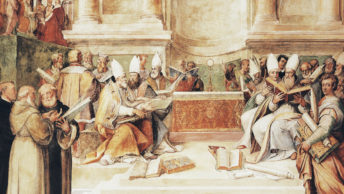For Catholics, as well as Jews and other Christians, the story of man’s relationship with woman begins in the Book of Genesis with God making Adam from the dust and Eve from Adam’s rib, and the two subsequently eating the forbidden fruit—Eve after succumbing to the serpent’s tempting, and Adam following her example. In time, when God asked them to account for their behavior, Adam blamed Eve and Eve blamed the serpent.
That response was the first recorded example of scapegoating—that is, blaming others for one’s mistakes and offenses—a practice that has been employed ever since in both religious and secular affairs. And since men have almost always been in charge of interpreting events, women have been disproportionately scapegoated. The most shameful example of this practice has been the denigration of women in Catholic (and other Christian) theology.
Adam’s blaming of Eve for his expulsion from the Garden became the model for Catholics and other Christians despite the New Testament’s very different message (See 1 Cor. 7.1-2). Consider these statements by influential Church Fathers, all but one of them canonized saints:
St Clement of Alexandria (died 220): “A woman should cover her head with shame at the thought that she is a woman.”
Tertullian (d. 220): “God’s sentence hangs still over all your sex and His punishment weighs down upon you . . . You are she who first violated the forbidden tree and broke the law of God . . . Because of the death you merited, even the Son of God had to die . . . Woman, you are the gate to hell.”
St John Chrysostom (d. 407): “Woman is a foe to friendship, an inescapable punishment, a necessary evil . . . Among all savage beasts none is found so harmful as woman.”
St Jerome (d. 430): “Women are the gate of hell.”
St. Augustine (d. 420): “Woman together with her own husband is the image of God . . . but when she is referred [to] separately . . . then she is not the image of God . . . [But the man] is the image of God as fully and completely as when the woman too is joined with him in one.” [The clear suggestion is that women occupy a lesser level of humanity than men.]
Pope St Gregory the Great (d. 604): “Woman is slow in understanding, and her unstable and naive mind renders her by way of natural weakness to the necessity of a strong hand in her husband.”
Such outright contempt for women could not help but influence those who crafted moral theology, particularly in the matter of sexual intercourse. As Elizabeth M. Makowski notes, St. Paul had taught that the purpose of marital intercourse was “not specifically procreative” but instead a “conjugal obligation, binding both husband and wife,” that provided “a safeguard against human weakness.”
In contrast, Makowski explains, 4th century theologian St. Augustine, taught that Adam and Eve’s “original sin” had corrupted the sex act for all time by making it an act of passion, and that taint could only be removed when the purpose of the act was procreation (or the rendering of the “marital debt” to one’s spouse). This view of sexuality, which very likely reflected both Augustine’s remorse over his own sinful youth and his negative attitude toward women, influenced Catholic theology for many centuries, in some ways even to this day.
In the 12th century, the canonist Gratian somewhat tempered Augustine’s view of marital intercourse, saying that intercourse served, in Makowski’s words, “not only for the procreation of children, but also as a remedy for man’s sinful nature.”
In the late 13th century, Makowski notes, two individuals strongly influenced by St. Augustine were Italian canon lawyer Huguccio and Pope Innocent III. The former “maintained that carnal union could never take place without sin. . . [linking] coitus to concupiscence, and concupiscence to pleasure.” Pope Innocent III claimed that “conjugal intercourse is never committed without itching of the flesh, and heat, and foul concupiscence, whence the conceived seeds are befouled and corrupted.” {Emphasis added in both cases.]
In the 17th century Pope St. Gregory the Great declared that, in Makowski’s words,“the evil of marital coitus did not consist in the act itself, or in the concupiscence which impelled men to act irrationally[but in the] sensual pleasure, even when only experienced incidentally . . . [Gregory’s argument was therefore] “that coitus could never be without sin because the pleasure inherent in the act was never without fault.”
By the mid-13th century, Makowski explains, “the substantive law of the Church concerning marriage had crystallized,” adding that “the movement away from Augustinian pessimism [had been] slow, and some would contend, incomplete.” Makowski concludes, “there can be little question that the general uneasiness about human sexuality evident in canonical writing pervaded the consciousness of medieval people [and] is still a part of their legacy to us.”
Taken together, these views represent the following perspective on women:
Women are shameful: they caused us all, including the Son of God, to merit death; they are savage beasts; temptresses; gates to Hell; foes to friendship; and dim witted, naïve, unstable, creatures with whom sexual intercourse is always sinful, even when it produces children.
This perspective would be offensive if it denigrated an ethnic group or a race, but it goes far beyond that and denigrates categorically and without exception an entire gender comprising one half of all humanity. It is at very least reprehensible. Some would call it absurd, even insane, for it is tantamount to saying either that God made a terrible mistake in creating woman, or that God created Adam and Satan created Eve.
Lamentably, Catholic teaching on women and marriage was marinated in that perspective for centuries and is now well baked into the Church’s moral theology. Of course, even the strictest adherents of that perspective thought more charitably of their mothers, sisters, celibate female saints, and the Blessed Virgin Mary. But the basis for their charity was more emotional than logical and did not diminish the force of their condemnation of women.
The fact that this perspective on women has been in place for centuries helps to explain the following teachings and regulations.
Marital Intercourse. Pope Paul VI’s encyclical Humanae Vitae declared that “Marriage and conjugal love are by their nature ordained toward the procreation and education of children,”that “each and every marital act must of necessity retain its intrinsic relationship to the procreation of human life,” and, therefore, that “sexual intercourse which is deliberately contraceptive” is “intrinsically wrong.” The basis of that declaration was not Scripture but instead St. Augustine’s contention, noted above, that Adam and Eve had made sexual intercourse an act of passion and thus corrupted it for all time. That corruption, Augustine argued, can be mitigated by keeping the sex act open to procreation. Pope Paul clearly assumed that because Augustine was both a brilliant man and a saint, he could not possibly have been wrong in his claim that sex for Adam and Eve (a) was passionless before the Fall, (b) became passionate afterward, and (c) continues to be sinful because of that passion. Paul’s assumption was unwarranted. Even brilliant saints can be mistaken and that fact in no way detracts from their intellects or their holiness. How could Augustine have erred? By being so remorseful over his own sexual sins that he was unable to see the passion he had experienced outside of marriage as being good and even holy within marriage.
Celibacy for Priests: The stated reason that priests are not allowed to marry in the western Church is that celibate life produces more effective pastoral service. (This despite the fact that priests in the eastern tradition and Protestant pastors are not hampered by marriage and fatherhood, nor are married Catholic deacons any less effective than celibate deacons.) The deeper, unstated reason for a celibate clergy is that, according to the most influential Church Fathers, coitus is never without sin, therefore married clergy would be habitual sinners, and such sin would destroy the integrity of the priesthood.
Exclusion of Women from the Diaconate and Priesthood: The stated reason that neither the diaconate nor the priesthood has been open to women is that Christ chose only men as His apostles. The unstated arguments are that in the view of the Church Fathers, women by their very nature are unfit to serve in those offices and that because of that nature, women’s presence in seminaries and in parishes would cause lustful thoughts and actions in men. (The latter clause is an extension of the scapegoating first used by Adam—“My sin was her fault.”)
As the three above examples demonstrate, though the historic calumny against women is no longer openly expressed, it continues to inform many Catholic teachings. And in that contradiction irony abounds: The Church preaches Jesus’ command that we love our neighbors as we love ourselves even as they embrace a hateful attitude toward fully half the neighbors in the world. The Church gives fulsome praise to marital intercourse in theory while treating it as sinful in practice. And many in the hierarchy remain convinced that female priests and/or married male priests would corrupt the priesthood, yet they have little or no concern that homosexual priests have been doing that very thing and, worse, perhaps earning a millstone around their necks in the process .
It is impossible to imagine that God is pleased with Catholicism’s centuries-old, institution-wide calumny against women. Nor is it sensible to accept the notion that changing major teachings would cause scandal. The scandal lies in the offense, not in its acknowledgment or remediation.
Nowhere does Scripture say, “Take as long as you want, even several centuries, to remedy wrongs.” It says without the slightest ambiguity, “When you are offering your gift at the altar, if you remember that your brother or sister has something against you, leave your gift there before the altar and go; first be reconciled to your brother or sister, and then come and offer your gift. (Matt 5: 23-24) [Emphasis added]
I believe the hierarchy of the Catholic Church should honor that command by making the following pronouncements:
Many distinguished Church Fathers interpreted the story of Adam and Eve’s sin incorrectly, and their error has tainted many of the Church’s teachings over the centuries. We, the Catholic hierarchy, acknowledge our obligation to correct these errors.
The correct interpretation of the biblical story is that both Adam and Eve were equally created in the image and likeness of God and both sinned equally. As a result, their male and female progeny have been equally tainted—the minds of both have been clouded, and the wills of both weakened. Both are therefore equally vulnerable to temptation and to sin.
The correct understanding of marriage is that it is an exclusive relationship between a woman and a man based on unselfish, mutual love and following Christ’s command to love one another as He has loved them. Marriage has emotional, spiritual, and physical dimensions, each of which is to be nurtured prayerfully. When a couple wishes to have one or more children, and God grants that wish, they become responsible for guiding the child to grow in knowledge and virtue and to love God and neighbor. The decision to prevent contraception is a matter of conscience that only God can judge. The Church will no longer judge it. (The decision to end a pregnancy, however, involves the taking of an innocent human life created at conception in the image and likeness of God. Therefore, the Church will continue to condemn that act.)
Married men have been excluded from the priesthood, and women from both the priesthood and the diaconate, in large part, because of the Church Fathers’ mistaken—and grievously hurtful—views of the nature of women. To maintain those exclusions would perpetuate those views. Therefore the exclusions will no longer remain in effect.
For the hierarchy to make these pronouncements will take extraordinary courage. One reason is fear that the Church will lose creditability for having taught error for centuries. Another is that two of the changes concern teachings on contraception and the ordination of women that some believe have been infallibly taught. Yet another reason is the thorniness of the doctrine of infallibility itself, which was vigorously contested at Vatican I and, despite its presumed finality, is still questioned a century and a half after it was declared. (For a detailed discussion of the issue of Infallibility, see my four-part essay, “Understanding Infallibility,” at this site.)
As I have noted elsewhere, such changes in Catholic teaching could cause a number of Catholics to leave the Church, but it is no less likely that most would remain, many who have left would return, and some people of other faiths or no faith would be drawn closer to Catholicism. After all, a display of genuine humility, particularly from those in positions of great authority, has a way of evoking respect and admiration—and, where appropriate, forgiveness—from all who witness it.
Copyright © 2019 by Vincent Ryan Ruggiero. All rights reserved








9/2019
Professor Ruggiero spends considerable type to establish a rather bizarre thesis for his contention that the Church should sanction – even promote – the practice of contraception, priestly celibacy, and the ordination of women to the deaconate and to the priesthood.
His thesis, based upon a cherry-picked review of statements by some Church Fathers including St. Clement, Tertullian, St. John Chrysostom, St. Jerome, St. Augustine, and Pope St. Gregory the Great, is that: “Taken together, these views represent the following perspective on women: Women are shameful: they caused us all, including the Son of God, to merit death; they are savage beasts; temptresses; gates to Hell; foes to friendship; and dim-witted, naïve, unstable creatures with whom sexual intercourse is always sinful, even when it produces children.”
The prof. goes on to say, following this thesis: “Lamentably, Catholic teaching on women and marriage was marinated in that perspective for centuries and is now well baked into the Church’s moral theology.”
Where to start? With respect to his ridiculous thesis and more particularly to his position on contraception I ask: Professor, have you even read Humanae Vitae?
You say that HVs declaration that – “sexual intercourse which is deliberately contraceptive is intrinsically wrong” – is based “not on Scripture” but rather “Pope Paul clearly assumed that because St. Augustine was both a brilliant man and a saint” his (St. Augustine’s) contention “that Adam and Eve had made sexual intercourse an act of passion and thus had corrupted it for all time …etc., etc.”. Nowhere Prof., is there any mention in HV of St. Augustine. This kind of reckless speculation should be seen as a mile-marker on the road to perdition.
Pope Paul’s encyclical focuses repeatedly and consistently on the beauty and sacredness of marriage and the family and the equality of the spousal relationship. It focuses, as it says, on “the principles of the moral teaching on marriage—a teaching which is based on the natural law as illuminated and enriched by Divine Revelation”. The Prof, in advocating the repeal of this teaching is advocating the corruption of Church teaching on Divine Revelation.
The Prof’s rationale and perceived “unstated reason(s)” for ending priesthood celibacy is similarly flawed and demonstrates a gross misunderstanding of the priesthood as does his advocacy for female ordination.
Professor Ruggiero may be more comfortable with his inclinations if he were to seek out a Protestant sect more in conformance to his thinking.